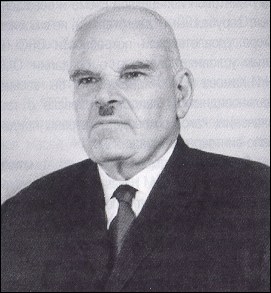All the World's Rotorcraft
Part I |
Part II |
Part III |
Part IV |
Part V
3. The history of the Kamov Design Bureau
The spectacular demonstration of the Ka-8 to the numerous onlookers and the leaders of the country became an historic event which sealed the destiny of the group of enthusiasts who had built the mini-helicopter. On the following day N.I.Kamov was invited to the Ministry of Aviation Industry. The vice-minister proposed to Kamov that he become the head of a small design bureau with a view to building a helicopter similar to the Ka-8. At the same time he conveyed congratulations from Stalin in connection with the successful demonstration and informed Kamov about the interest towards the helicopter displayed by Flt. Adm. Kuznetsov. On October 7, 1948 the Minister of Aviation Industry M.V.Khrunichev issued Directive No.772 ordering the establishment of the Experimental Design Bureau No.2 (OKB No.2) headed by N.I.Kamov. The OKB was to be hosted by the State All-union Experimental Factory No.3 in Sokol'niki, a district of Moscow. In accordance with this directive all the specialists of the group which had been developing the Ka-8 on a voluntary basis were transferred to Kamov's OKB-2. Hence October 7, 1948 is regarded as the birthday of the OKB which subsequently became a world-renowned helicopter company. However, to do justice to history, one ought to regard the pre-war year of 1940 as the year of the company's establishment. Its founder Nikolai Il'yich Kamov was born in 1902. In 1923 he graduated from the Tomsk Technological Institute. From 1923 to 1931 he worked at a number of the USSR's aircraft factories having various posts, including those of brigade chief and leading designer in the design bureau of D.P.Grigorovich. From 1931 to 1948 (with short pauses) he headed separate brigades and an experimental design group in TsAGI. Between 1928 and 1943 he was engaged in the design and construction of autogyros. In 1945 he started the design work on a co-axial helicopter. The aircraft factory No.3 of the Ministry of Aviation Industry was considered to be, for all practical purposes, the base enterprise of the OKB headed by chief designer I.P.Bratukhin. It comprised several production shops and divisions, including the flight test facility at the Izmaylovo airfield (then a suburb of Moscow). The OKB-2 occupied the rooms allocated to it at the premises of this enterprise. Its staff rendered considerable assistance to the speedily growing brigades of the OKB-2 in establishing themselves and gaining the necessary practical experience in design and calculation work. The specialists of the young OKB started work on a co-axial helicopter for observation and liaison duties which was designated Ka-10. It was designed to meet a general operational requirement (GOR) submitted by the Naval Air Arm. The configuration of the new rotorcraft was similar to that of the Ka-8. The helicopter was powered by a 35hp AI-4G engine specially designed by Chief Designer A.G.Ivchenko. The rotor diametre was increased by 0.2m, blade camber was introduced. Significant changes were made to the helicopter's control system. Unlike the Ka-8, the Ka-10 helicopters were built in the normal conditions of an aircraft factory. In order to check the proper functioning and reliability of subassemblies, units and systems, a considerable amount of laboratory and bench trials was conducted in parallel with the construction of the prototypes. Within a short time four helicopters were built. One of them underwent 100-hour fatigue testing, the others were used under the flight test programme. The Ka-10 made its first flight on August 30, 1949 with test pilot M.D.Gurov at the controls. The helicopters were fitted with the necessary test data recording devices. Factory tests of the Ka-10 were completed by test pilot D.K.Yefremov replacing M.D.Gurov who was tragically killed in one of the test flights. The test programme comprised 200 flights totalling 25 flight hours. In October 1950 two Ka-10 helicopters were handed over to the Soviet Air Force for State acceptance (Stage 2) trials. The nights under the Stage 2 test programme were performed by NII VVS project test pilot Captain Ye.A.Gridyushko. Trials under maritime conditions were conducted on the light artillery cruiser "Maxim Gorkiy". These were the first flights of a helicopter from a ship in our country. 1950 can be regarded as the year when Soviet shipboard aviation came into being. The pilots remarked that shipboard helicopter operations had a few quirks: the increased turbulence of the airflow and the ship's rolling and pitching which complicated take-off and landing, etc. Yet they noted that the helicopter presented no problems for average-skilled pilots. The State trials confirmed the high manoeuvrability of the co-axial helicopter and its suitability for shipboard service. In August 1951 it was decided to build a production batch of 15 Ka-10s for the Armed Forces with a view to a more profound investigation of the rotorcraft's uses for various naval tactical purposes. Service trials of the Ka-10 were conducted on the Black Sea by a specially formed naval helicopter squadron commanded by Captain A.N.Voronin. Building on the experience of ground and flight operations accumulated with the prototypes, the specialists of the OKB introduced a number of changes into the Ka-10's design to further improve the helicopter. "...The design of a real mini-helicopter was finalized and received the designation Ka-10M", said N.I.Kamov. The Ka-10M was used for several years for research and demonstration purposes. The OKB became firmly established after the completion of the development phase of the Ka-10 and the Ka-10M which marked the start of co-axial helicopters in the Soviet Union. A major contribution to the creation of the Ka-10 and Ka-10M helicopters was made by the OKB workers V. B. Barshevsky, M.A.Kupfer and AJ.Vlasenko.
From "OKB Kamov. 50 years" by G.I.Kuznetsov


The founder of the Design Bureau and its first Chief Designer
